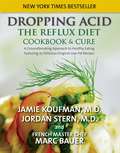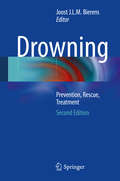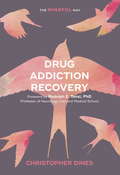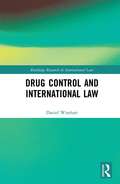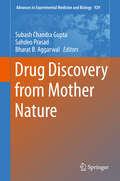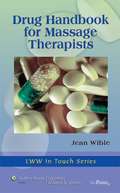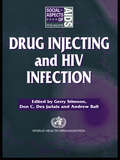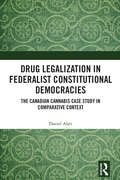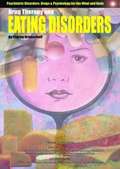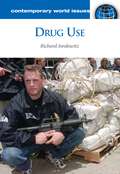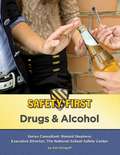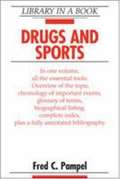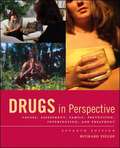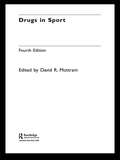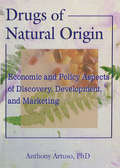- Table View
- List View
Dropping Acid
by Jordan Stern Jamie KoufmanDropping Acid: The Reflux Diet Cookbook & Cure is the first book to explain how acid reflux, particularly silent reflux, is related to dietary and lifestyle factors. It also explains how and why the reflux epidemic is related to the use of acid as a food preservative.Dr. Koufman defines the symptoms this shockingly common disease and explains why a change in diet can alleviate some of the most common symptoms. Dropping Acid offers a dietary cure for acid reflux, as well as lists of the best and worst foods for a reflux sufferer. The book's recipes use tasty fats as flavorings, not as main ingredients; included are the recipes for tasty dishes that prove living with reflux doesn't mean living without delicious food.
Drowning
by Joost J.L.M. BierensSince the first edition of the Handbook on Drowning in 2005, many epidemiological data have confirmed the burden of drowning in several parts of the world. Studies have increased the understanding of effective drowning prevention strategies, rescue techniques and treatment options. Much has been learned about submersion and immersion hypothermia, SCUBA-diving injuries, the life-saving preparations of water-related disasters and how to deal with forensic investigations. In this updated second edition, experts from around the world provide a complete overview of current research data, consensus statements and expert opinions. The book Drowning provides evidence-based practical information and has a unique informative value for various groups with tasks, duties and responsibilities in this domain. In addition, the book may be an inspiration for future networks and research initiatives.
Drug Abuse Sourcebook (2nd edition)
by Catherine GintherThe second edition of this sourcebook compiles 70 recent contributions by health and government agencies in seven topic areas: introduction to drug abuse, the nature of drug addiction, drugs of abuse, recognizing and treating drug abuse, drug-related health risks, prevention, and additional resources. The latter includes a glossary of drug-abuse related terms, a glossary of street terms, and a directory of national resources. Individual chapter topics include drug use and crime, stress and drug abuse, OxyContin, methamphetamine abuse linked to brain damage, and fetal and childhood development. Annotation ©2004 Book News, Inc., Portland, OR (booknews.com)
Drug Addiction Recovery: The Mindful Way
by Christopher Dines'A process for healing from paralyzing grief, addiction and emotional wounds.' - Rudolph E. Tanzi, PhD, New York Times bestselling author.Healing from addiction can be an intensely painful process as decades of frozen grief are unpacked. This book is written to help recovering addicts to work through old wounds including bereavement, abandonment, betrayal, and abuse. It uses effective mindfulness practices to complement long term recovery and to help process sometimes-overwhelming feelings. Mindfulness is also recognized as a powerful tool in relapse prevention. Interspersed with personal reflections from the author's own experience, and stories from those with similar experience, this book balances insight and support with practical strategies and mindfulness tools.Covering everything those recovering from addiction might need to know, including the need to grieve, coping with depression and shame, and spiritual wellbeing, it also offers a number of guided meditations as well as a variety of different exercises.For those building emotional wellbeing and peace in recovery, Drug-Addiction Recovery: The Mindful Way offers healing ways to enhance self-respect, and points the path to serenity.
Drug Addiction Recovery: The Mindful Way
by Christopher DinesHealing from addiction can be an intensely painful process as decades of frozen grief are unpacked. This book is written to help recovering addicts to work through old wounds including bereavement, abandonment, betrayal, and abuse. It uses effective mindfulness practices to complement longterm recovery and to help process sometimes overwhelming feelings. Mindfulness is also recognised as a powerful tool in relapse prevention. Interspersed with personal reflections from the author?s own experience, Drug Addiction Recovery suggests ways to come to terms with the past and to live peacefully in the present. Topics include:the nature of addictionassociated addictive or dysfunctional behaviourswhy we need to grievemindfulness and the braincoping with depression, shame and alienationguided meditationswritten and verbal exercisesrecovery storiesFor those building emotional and spiritual wellbeing in recovery, CHRISTOPHER DINES offers ways to enhance self-respect, and points the path to serenity.
Drug Control and International Law (Routledge Research in International Law)
by Daniel WisehartThis book provides for an extensive legal analysis of the international drug control system in light of the growing challenges and criticism that this system faces. In the current debate on global drug policy, the central pillars of the international drug control system – the UN Drug Conventions as well as its institutions – are portrayed as outdated, suppressive and seen as an obstacle to necessary changes. The book’s objective is to provide an in-depth and positivist insight into drug control’s present legal framework and thus provide for a better understanding of the normative assumptions upon which drug control is currently based. This is attained by clarifying the objectives of the international drug control system and the premises by which these objectives are to be achieved. The objective of the current global framework of international drug control is the limitation of drugs to medical and scientific purposes. The meaning of this objective and its concrete implications for States’ parties as well as its problems from the perspective of other regimes of international law, most notably international human rights law, are extensively analysed. Additionally, the book focuses on how the international drug control system attempts to reach the objective of confining drugs to medical and scientific purposes, i.e. by setting up a universal system that exercises a rigid control on drug supply. The consequences of this heavy focus on the reduction of drug supply are outlined, and the book concludes by making suggestions on how the international drug control system could be reformed in the near future in order to better meet the existing challenges. The analysis occurs from a general international law perspective. It aims to map the international drug control system within a wider context of international law and to understand whether the problems that the international drug control system faces are exemplary for the difficulties that institutionalized systems of global scope face in the twenty-first century.
Drug Discovery from Mother Nature
by Bharat B. Aggarwal Subash Chandra Gupta Sahdeo PrasadSecond comprehensive volume focuses on anti-inflammatory nutraceuticals and their role in prevention and therapy of various chronic diseases. Food and drug administration (FDA) approved drugs such as steroids, non-steroidal anti-inflammatory drugs (NSAIDS), statins and metformin have been shown to modulate inflammatory pathways, but their long-term intake has been associated with numerous side effects. Thus dietary agents which can modulate inflammatory pathways in humans, are likely to exhibit enormous potential. Leading experts describe the latest results of anti-inflammatory nutraceuticals and their role in prevention and therapy of various chronic diseases.
Drug Handbook for Massage Therapists
by Jean M. WibleDesigned for quick reference, this first-of-its-kind handbook instantly answers the massage therapist's questions about any drug a client may be taking, including how the drug may affect the application of massage, which cautions and contraindications may exist, and which changes in the massage session may be required for a client taking the drug. Drugs are listed alphabetically by generic name and each drug entry includes pronunciation; brand names; effects on the body; diseases, disorders, and symptoms the drug treats; possible side effects; onset-peak-duration table; and massage considerations.
Drug Information: A Guide for Pharmacists
by Patrick M. Malone Karen L. Kier John E. StanovichThis well-known guide teaches pharmacists and pharmacy students how to more effectively and efficiently research, interpret, utilize, organize, and distribute drug information.
Drug Injecting and HIV Infection (Social Aspects of AIDS)
by Gerry V. Stimson Don C.Des Jarlais Andrew L. BallDrug Injecting and HIV Infection is a comparative international study of drug injecting behaviour and HIV infection based on the World Health Organization's study of 13 cities as disparate as Athens, Bangkok, Glasgow and Rio de Janeiro. Using a standardized methodology for the collection of data, as well as central data management and analysis, this study represents the largest international project of its kind. It presents a comprehensive overview of what is currently known about drug injecting, HIV infection, epidemic dynamics and possibilities for prevention. Stressing the importance of linking research to intervention and policy, the contributors emphasize the need to place HIV and policy issues on the international agenda. Written by experts in the field, this global study offers an in-depth and definitive analysis of the subject.
Drug Legalization in Federalist Constitutional Democracies: The Canadian Cannabis Case Study in Comparative Context
by Daniel AlatiThis book uses the Canadian Cannabis legalization experiment, analyzed in the historical context of wider drug criminalization in Canada, and placed in international perspective, to examine important lessons about the differential implementation of federal law in jurisdictions within federalist constitutional democracies. Utilizing a socio-legal, interdisciplinary methodology, the work provides a comprehensive history of federal drug policy and engages in a critical appraisal of its provincial implementation. It also presents a significant international and comparative component, bringing in analyses of the status of drug legalization in other federalist constitutional democracies. Readers of the book will thus gain a comprehensive knowledge of drug legalization in federalist constitutional democracies. They will also better understand the political and cultural factors that impact upon differential implementation of federal law in individual jurisdictions including, but not limited to, legacies of racism and stigmatization of drug use. Using the experience of Canada and other countries, future challenges and lessons to be learned for states considering federal drug legalization are analysed and explained. The book will be a valuable resource for students, academics and policy-makers in the areas of Criminal Law, Constitutional Law, Criminology, Socio-Legal Studies, Indigenous Studies, and Drug and Health Policy Studies.
Drug Muggers: Which Medications Are Robbing Your Body of Essential Nutrients--and Natural Ways to Restore Them
by Suzy CohenUnpleasant, uncomfortable, and unexplained side effects? Drug Muggers is your side effect solution.Prescription and over-the-counter drugs help millions of people with devastat-ing diseases and chronic conditions. But in the process, these medications can also deplete the body's natural stores of vitamins, minerals, and hormones—the very nutrients you need to keep energy levels high, fend off infections, and be healthy. Pharmacist Suzy Cohen calls these medications "drug muggers," and she says it's essential to replenish what a drug mugger steals from your body in order to feel your best and avoid side effects. Not understanding the drug-mugging effect may lead to new "diseases" and possibly catastrophic health con-sequences.You'll discover: • How to relieve uncomfortable or potentially serious side effects • How to remain compliant with your medication and still feel well • Which foods and drinks to avoid if you take certain medications • How to install a nutrient security system with vitamins, minerals, and food choices Plus! • Improve your energy levels • Learn which minerals you need if you take heartburn medicine • Improve digestion and relieve constipation with a simple nutrient • Discover the antioxidant you must have to save your heart • Get your hair and nails to grow faster by replenishing nutrients • Find out which vitamins and minerals are the purest and highest quality • Learn which vitamins outperform medications in some cases Drug Muggers is an eye-opener! It reveals why you may be feeling so poorly and how to improve your well-being with affordable nutrients that are sold over the counter. You can (and will) improve the way you feel—whether or not you take medicine!
Drug Therapy and Eating Disorders (Psychiatric Disorders: Drugs and Psychology for the Mind and Body)
by Shirley BrinkerhoffDrug Therapy and Eating Disorders tells the stories of two young women who struggle with anorexia and bulimia and how they found help. Although eating disorders are among the most difficult of psychiatric illnesses to treat, new advances in care are being made. Many individuals with eating disorders are helped by concerned health professionals and by treatment programs that use the latest medical, behavioral, and pharmacological therapies. In this book, you will learn about eating disorders, the devastating effects they can have, and the treatments that can bring hope back to sufferers' emaciated lives.
Drug Treatment of Sleep Disorders
by Antonio GugliettaFollowing reviews on sleep physiology, regulation, pharmacology, and the neuronal networks regulating sleep and awakening, as well as a classification of sleep disorders, this book presents a number of major breakthroughs in the treatment of those disorders. These include recently approved drugs for treating insomnia, such as Doxepin; variations on previously approved molecules, e. g. Zolpidem sublingual preparation; or new chemical entities in advanced stages of clinical development, e. g. Orexin antagonists. Further topics discussed include drugs acting on the GABA receptor, such as Lorediplon and Eszopiclone; the treatment of excessive daytime drowsiness with cell therapy and drugs such as Modafinil, Armodafinil and Sodium oxybate; and the use of Tasimelteon in the treatment of circadian sleep disorders.
Drug Use
by Richard IsralowitzThe use of tobacco, alcohol, marijuana, heroin, cocaine, and other substances is a deeply imbedded characteristic of most societies. It often shows itself in the form of illness, death, crime and violence, police action and imprisonment, property confiscation, massive allocations of governmental resources, as well as many ways of human suffering. It tends to attract more concern and attention than any other social issue throughout the world.
Drug- & Alcohol-Related Health Issues: A Teen's Guide To Drug- And Alcohol-related Health Issues (Young Adult's Guide to the Science of He)
by Joan EsherickAs an adolescent, you'll have to make up your mind about a lot of things. Drugs and alcohol are among the most important. Using chemicals recreationally is a common aspect of many teen parties. No one sets out to become addicted. No one plans on any harmful side effects. But these things do happen. You owe it to yourself to find out the facts about drugs and alcohol. This book will tell you: *Some of the reasons why teens choose to start using drugs. *How chemical substances affect your brain. *Information about the "gateway" drugs--tobacco, alcohol, marijuana, and inhalants. *The truth about abusing prescription drugs, over-the-counter medications, and steroids. *The dangers involved with Ecstasy and other club drugs, as well as heroin. Don't depend on peer pressure to make up your mind. Drugs and alcohol can permanently damage your life. You don't want to be one of the teens who is literally dying for acceptance!
Drugs & Alcohol
by Kim EtingoffDrugs and alcohol are dangerous no matter how old you are, but for kids, the risks of using drugs or alcohol are even more serious. Even though many young people know that drugs and alcohol can be deadly, they still put themselves in harm's way by using these unsafe substances.
Drugs Across the Spectrum (6th edition)
by Raymond GoldbergIn this undergraduate textbook, Goldberg (State U. of New York at Cortland) surveys the physiological, psychological, and sociological literature on the use and abuse of licit and illicit drugs. Opening chapters provide an overview of drugs in contemporary society, motivations for drug use, drugs and the law, and the pharmacology and physiology of drug use. The psychological and physiological effects of drugs are then explored in individual chapters covering alcohol; tobacco; narcotics; sedative-hypnotic drugs; psychotherapeutic drugs; stimulants (cocaine, amphetamines, and caffeine); marijuana; and over-the-counter drugs. A final pair of chapters summarizes the research on substance abuse treatment and drug prevention and education. Annotation ©2005 Book News, Inc., Portland, OR (booknews.com)
Drugs During Pregnancy
by Bengt KällénThis book addresses methodological aspects of epidemiological studies on maternal drug use in pregnancy. Discussing the existing sources of error and how they can produce incorrect conclusions, it examines various epidemiological techniques and assesses their strengths and weaknesses. These refer both to the identification of outcomes (with special emphasis on congenital malformations) and to the types of exposure (drug use). Further, the book discusses the problem of confounding and how to handle it, and provides a simple introduction to statistics. Special situations, e. g. different types of parental exposure, are examined. Lastly, the book discusses pharmacovigilance and the information problem, concluding with a short list of aspects to consider when one wants to evaluate a published paper in the field. Though the book is primarily intended for pharmacologists, gynecologists and obstetricians, it will benefit all doctors working in perinatal care.
Drugs and Society
by Glen R. Hanson Annette E. Fleckenstein Peter J. VenturelliThoroughly revised and updated, Drugs and Society, Eleventh Edition, contains the most current information available concerning drug use and abuse. Written in an objective and user-friendly manner, this best-selling text continues to captivate students by taking a multidisciplinary approach to the impact of drug use and abuse on the lives of ordinary people. The Eleventh Edition incorporates the authors#146; combined expertise in pharmacology, drug abuse, and sociology and extensive experience in research, teaching, drug policy-making, and drug policy implementation and includes hundreds of new citations that reflect the current state of drug abuse issues and the rapidly changing issues of substance abuse/addiction.
Drugs and Sports
by Fred C. PampelPampel (sociology, University of Colorado) chronicles the use of performance-enhancing drugs in American sports, and reviews the major laws and court cases involving drug use and testing. Extensive reference chapters provide brief biographical sketches of players and scientists, cite books and articles on both medical and social aspects of the issue, and list government and sports agencies. Appendices reprint the Anabolic Steroid Control Acts, the Supreme Court decision on drug testing of student athletes, and NIDA research reports. Annotation ©2007 Book News, Inc., Portland, OR (booknews.com)
Drugs in America: A Social History, 1800-1980
by H. Wayne MorganThis book developed out of my general interest in the late nineteenth century. While reading through the popular press in connection with another project, I discovered a great deal of comment on the "opium problem," and on drug use in general. I unearthed several addict memoirs and other unusual sources, and the medical literature proved a gold mine of information. After further research, it seemed to me that a brief general survey of the question with some depth and fresh information was in order, and this book is the result.
Drugs in Perspective (7th edition)
by Richard FieldsThis text is designed for the drug and substance abuse counseling course that prepares future health professionals to work with patients, clients, and families of abusers.
Drugs in Sport (4th Edition)
by David R. MottramWith the recent major updates in worldwide anti-doping laws and changes to the prohibited and therapeutic exemption lists, this fourth edition of the bestselling Drugs in Sport presents authoritative, hard science information about the actions of drugs, hormones, medication and nutritional supplements in sport. Written by a well respected pharmacologist from one of the UK's leading sports science universities, this much-needed new edition of a market leader continues to focus on one of the most high profile themes in sport science, providing high quality detailed information. Some of the key issues covered include: *the latest doping control regulations of the WADA *the use of therapeutic drugs banned in sport *an assessment of the prevalence of drug taking in sport.
Drugs of Natural Origin: Economic and Policy Aspects of Discovery, Development, and Marketing
by Anthony ArtusoDespite the growing interest in biodiversity as a source of valuable new products and biochemical information, there have been very few systematic efforts to estimate the value of preserving biological resources for this purpose. Drugs of Natural Origin gives you a detailed model of the value of wild biological resources for pharmaceutical research and development. Author Anthony Artuso presents several decision models and analytical techniques that you can use to assess the economics of biochemical prospecting efforts whether you’re part of a private corporation, nonprofit research institute, developing country government, or international organization.Drugs of Natural Origin explores the policy options available to developing countries and international organizations to tap into the emerging market for biological resources in such a way as to provide both incentives for conservation of biodiversity and new opportunities for economic development. You’ll find evaluations of a range of proactive strategies that can be used to protect and enhance developing countries’biological resources. In addition, you’ll learn about a bioeconomic model that incorporates the potential biochemical and genetic value of a diverse ecosystem into land use planning and development.Developing country and international policymakers will find Drugs of Natural Origin a useful tool for determining how best to conserve biodiversity, while sustainably developing biological resources. This book outlines a comprehensive and integrated set of policy measures, research and development initiatives, and financing arrangements that could increase biochemical research activity while providing incentives for conservation of biodiversity and a potential path for sustainable development.Managers of pharmaceutical R&D programs will use the decision models developed in Drugs of Natural Origin to plan, evaluate, and continually refine their R&D programs. The book’s theoretic framework provides you with an analytical tool for systematically evaluating critical decisions at each stage of the R&D process. Thus, you learn to incorporate both subjective assessments and quantitative data into a comprehensive framework for R&D decisionmaking.
